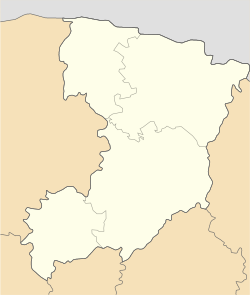Velyki Mezhyrichi
 From Wikipedia the free encyclopedia
From Wikipedia the free encyclopedia
This article needs additional citations for verification. (October 2016) |
Velyki Mezhyrichi Великі Межирічі | |
|---|---|
| Coordinates: 50°39′24″N 26°51′53″E / 50.65667°N 26.86472°E | |
| Country | |
| Oblast | |
| Raion | |
| Area | |
| • Total | 5,441 km2 (2,101 sq mi) |
| Population | |
| • Total | 2,192 |
| • Density | 0.40/km2 (1.0/sq mi) |
| Time zone | UTC+2 (EET) |
| • Summer (DST) | UTC+3 (EEST) |
| Postal code | 34725 |
| Area code | +380 3651 |
| Website | село Великі Межирічі/райцентр Корець/облцентр Рівне (Ukrainian) |
Mezhirichi (Ukrainian: Вели́кі Межи́річі, romanized: Velyki Mezhyrichi; Polish: Wielki Międzyrzecz) is a village in western Ukraine, in the Rivne Raion of Rivne Oblast, but was formerly administered within the Korets Raion. It is located 21 kilometres (13 mi) west of Korets and 43 kilometres (27 mi) east of Rivne. Local government is administered by Velykomezhyritska village council.[1]
Names
[edit]Mezhirichi is also known as Polish: Międzyrzec Korecki, Yiddish: מעזריטש, romanized: Mezritsh, Hebrew: מזריטש גדול, romanized: Mezritsh Gadol.
Jewish life in Mezhirichi
[edit]
Undoubtedly the most significant event in the Jewish community of Mezhirichi was the arrival there of the Maggid, Rabbi Dov Ber. After the death of the founder of Hasidism, the Baal Shem Tov, in 1761, Rabbi Dov Ber became the next leader of the movement. He moved to Rivne, and later to Mezhrichi, where he remained for the rest of his life. Mezhrichi rapidly became a magnet and place of pilgrimage for the chasidim. The location of Mezhrichi, nearer to Poland and White Russia than the Baal Shem Tov's seat in Medzhybizh, acted as a spur to the fledgling chasidic movement.
There is a Yizkor book memorializing the Jewish community that lived in the town prior to the Holocaust.[2]
History and attractions
[edit]The first written record of the village dates from 1544. However, archaeologists found in the area a settlement of Bronze Age and the Roman coins of II century AD.
The Magdeburg rights were provided for the village Mezhyrichi by the King of Poland Sigismund III Vasa in 1605. And in 1702 the owner of the village, Jerzy Lubomirski, started to build a stone church of St. Anthony in the village, which took 25 years to erect. The church was built on the place of an old wooden church, which had been erected by means of by Konstantine Ostrogski and which burned down in 1601.
Monuments of architecture national importance in the Rivne region is the stone church of St. Anthony (N - 1503 0) and Peter and Paul Church (wooden) (N – 1505 0) in the village Velyki Mezhyrichi.[3]
Gallery
[edit]- Peter and Paul Church (wooden) in the village Velyki Mezhyrichi.
- Church of St.Anthony in the village Velyki Mezhyrichi.
Notable people from Mezhirichi
[edit]- Dov Ber of Mezeritch, rabbi
- Isaak Ozer Löwenstein, rabbi whose daughter Lina married Edward Eliasz Luxenburg and gave birth to Polish revolutionary socialist Róża Luksemburg.
- Sholom Shachne of Prohobisht (birthplace)
References
[edit]- ^ Великомежиріцька сільська рада (in Ukrainian)
- ^ Alayon, Benzion H. (1955). Meziriṭsh gadol be-vinyana uve-ḥurbana. ʼIrgun ʻole Meziriṭsh be-Yiśraʼel, Taf Shin Ṭet Ṿaṿ (in Hebrew). Tel Aviv: בהוצאת אירגון עולי מז׳יריטש בישראל. OCLC 35177767.
- ^ Пам'ятки архітектури національного значення Рівненської області (in Ukrainian)





